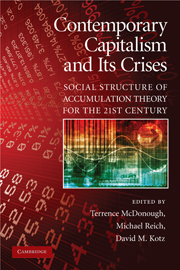Book contents
- Frontmatter
- Contents
- List of Tables
- List of Figures
- List of Contributors
- Acknowledgments
- Introduction: Social Structure of Accumulation Theory for the 21st Century
- PART I THE THEORY OF SOCIAL STRUCTURES OF ACCUMULATION
- PART II GLOBALIZATION AND THE CONTEMPORARY SOCIAL STRUCTURE OF ACCUMULATION
- PART III THE CONTEMPORARY SOCIAL STRUCTURE OF ACCUMULATION IN THE UNITED STATES
- PART IV SOCIAL STRUCTURE OF ACCUMULATION THEORY AND TRANSFORMATIONS OF THE CAPITALIST PERIPHERY
- 11 The Social Structure of Accumulation in South Africa
- 12 Social Structures of Accumulation and the Condition of the Working Class in Mexico
- 13 Social Structure of Accumulation Theory for the Arab World: The Economies of Egypt, Jordan, and Kuwait in the Regional System
- Index
- References
12 - Social Structures of Accumulation and the Condition of the Working Class in Mexico
Published online by Cambridge University Press: 05 June 2012
- Frontmatter
- Contents
- List of Tables
- List of Figures
- List of Contributors
- Acknowledgments
- Introduction: Social Structure of Accumulation Theory for the 21st Century
- PART I THE THEORY OF SOCIAL STRUCTURES OF ACCUMULATION
- PART II GLOBALIZATION AND THE CONTEMPORARY SOCIAL STRUCTURE OF ACCUMULATION
- PART III THE CONTEMPORARY SOCIAL STRUCTURE OF ACCUMULATION IN THE UNITED STATES
- PART IV SOCIAL STRUCTURE OF ACCUMULATION THEORY AND TRANSFORMATIONS OF THE CAPITALIST PERIPHERY
- 11 The Social Structure of Accumulation in South Africa
- 12 Social Structures of Accumulation and the Condition of the Working Class in Mexico
- 13 Social Structure of Accumulation Theory for the Arab World: The Economies of Egypt, Jordan, and Kuwait in the Regional System
- Index
- References
Summary
Introduction
Since 1982, Mexico has been facing a new model of accumulation. The new model replaces one that stood for fifty years. To situate the current stage of Mexico's capitalist development in a broader context, we use as a guide the idea of a social structure of accumulation (SSA): an articulated, historically specific set of institutions that organizes the process of capital accumulation in different ways in different locations and historical periods. Every historically situated model of accumulation is, in fact, an SSA. Almost every account of the twentieth century economic history of Mexico leaves aside the role of institutions in the accumulation process (see, e.g., Solís 1981; Lustig 1998). Even the most progressive accounts, such as (Moreno-Brid and Ros 2009), tend to downplay the relevance of several institutions and institutional arrangements that foster economic growth and capital accumulation.
And none examines how the resulting accumulation affects the growth of occupations and the evolution of wages. It is our contention that, by leaving aside these aspects of economic life, standard analyses of the Mexican economy are unable to explain the impact of the economic structure on the working class.
In this chapter we will show how the notion of an SSA is a useful tool to understand the evolution of the Mexican economy. We will also show that such a notion needs to take into account the institutional evolution of employment and income during most of the twentieth century, in order to better depict the living condition of the majority.
- Type
- Chapter
- Information
- Contemporary Capitalism and its CrisesSocial Structure of Accumulation Theory for the 21st Century, pp. 286 - 308Publisher: Cambridge University PressPrint publication year: 2010
References
- 3
- Cited by



